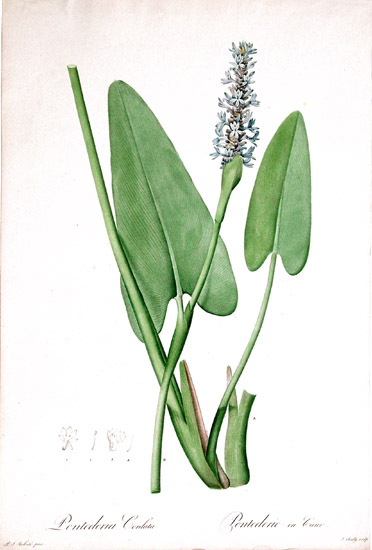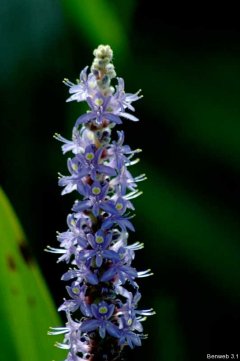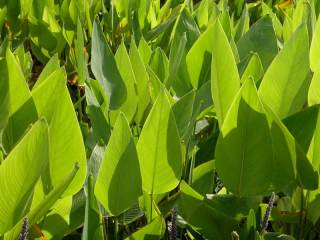In my day job, I spend a lot of time with my nose in dictionaries and style manuals. And today, while thumbing through Merriam-Webster’s Collegiate Dictionary, Eleventh Edition* (you see why in the trade we call it MW11), I ran across a headword (MW11 calls them “guide words”) that I actually know something about, and, what’s more, is on topic for a blog about nature in south Florida: pickerelweed.
Here is what the MW team has to say about the plant:
pick·er·el·weed \-,wed** n (1836) : a shallow-water monocotyledonous perennial plant (Pontederia cordata) chiefly of the eastern U.S. and Canada with large leaves and a spike of purplish-blue flowers
That definition is true enough, but it doesn’t go very far. And a picture is worth 1000 words (actually, the MW11 team thought of that, too, but I don’t want to scan their line drawing and break copyright; they have the picture on their own website, though, if you want to follow the link):
The image above shows the “pickerel” spike, but there’s much more to this plant than that. For one thing, the leaves, which, as MW11 admits, are large:
For another thing, the common name of the plant, pickerelweed, seems to come from its shape, which one must suppose, is somewhat like that of a pickerel. Whether this quick association makes sense, though, remains to be seen. So let’s go see!
According to MW11e, a pickerel is either what the Brits call a small pike (sounds reasonable enough), or:
either of two fishes resembling but smaller than than the related northern pike: (1): CHAIN PICKEREL (2): one (Esox americanus) of eastern No. America having green or red fins and a black bar below and slanting away from the eye 2 : WALLEYE 3 [which, if you follow that cross-reference, MW11 tells us is “a large vigorous No. American freshwater food and sport fish (Stizostedion vitreum) that has large opaque eyes and is related to the perches but resembles the true pike—called also walleyed pike
So, as far as I can tell according to MW11e, this plant, Pontederia cordata, must either look like a little British fish or a large vigorous North American fish. Of course, if you follow taxonomic changes, you’ll find that the MW11e team is a bit out of date; the walleyed pike is no longer called Stizostedion vitreum, but Sander vitreus. I assume that doesn’t change too much about the facts of the case, though: this plant must be the plant that looks like a fish, right?
Well, sort of. Actually, opinions vary. Maybe it’s a mistake to rely on one dictionary’s definition; let’s see what the American Heritage team brings to the table:
pick·er·el·weed n. A freshwater plant (Pontederia cordata) of eastern North America, having heart-shaped leaves with long petioles and spikes of violet-blue flowers.
Leaving aside the typographic considerations (AH actually uses periods at the end of their definitions! Hallelujah!), this definition does bring a bit more clarity to the issue. The leaves are described as heart-shaped; MW’s team is happy with the vague description “large.” AH also mentions that the petioles (what most people think of as “leaf stems”) are long; MW doesn’t seem to care about this. Then again, MW does provide a picture, which AH doesn’t, so maybe they were relying on those 1000 words to flesh out the missing details from their 25-word description. And when it comes right down to it, neither team has defined the plant all that well, despite having 64-dollar words like monocotyledonous or petioles.
Many botanical descriptions of the plant are much more helpful, explaining that the leaves are twice as long as they are wide, with heart-shaped BASES, etc. etc. The leaves do bear somewhat of a resemblance to the pickerel fish, although I suspect they look more like the namesake of the pickerel, which is the pike, itself named after its resemblance to the weapon:

Or was it the other way around? People were probably catching pikes to eat long before they were making them to keep people beyond sword’s length. MW11 tells us that the word for both the fish and the pointy spiky spear date from the 13th century. The Old English word pic, meaning sharp point, might be behind both words. (The verb form, to pike, comes from the French piquer, to prick.) Oh, for a good etymological dictionary! Speaking of which, the OED cites the pike as fish as far back as 1314; pike as sharp point goes back much, much further; pike as weapon dates from about 1275.
However, there is another option for the derivation of the name pickerelweed, one which makes at least as much sense as the association between the shape of the leaves and the shape of the pike-weapon or pike-food. According to a blog post by Ken Moore, a North Carolina blogger, “the common name, pickerelweed, refers to the pickerel fish, which feed along the edges of such emergent aquatic vegetation.” While I’ve not independently corroborated Moore’s research, this ecologically based derivation makes intuitive sense as well; the namers of things were much closer to the natural world than we are; it seems plausible that they would have named the pickerelweed after its ecological associate, the pickerel fish.
Moore’s source appears to be Paul Green’s Plant Book, which sounds delightful, as it apparently contains
daily observations and conversations with the local folks of the Cape Fear River valley, from Chapel Hill down through Lillington, Fayetteville and beyond. Plants take on a special dimension when accompanied with past and present human association.
Hear, hear! And here is a lovely old illustration of P. cordata from a 19th-century book on lilies that I found on Wikipedia:

As the Wikipedia entry tells us, the generic name of this plant was applied by Linnaeus himself, in honor of Giulio Pontedera, an Italian botanist from Padua who, ironically, did not accept Linnaeus’s system of binomial nomenclature. The italian Wikipedia entry tells us that he is responsible for discovering and naming several plant species (“A lui si deve la scoperta e classificazione di diverse specie di piante; la famiglia botanica delle Pontederiaceae è a lui dedicata.”), although the entry doesn’t tell us which species he discovered, or whether they retain the names he gave them, since he rejected Linnaean naming conventions.
The specific epithet, cordata, means “heart-shaped,” which refers to the leaves. (Please don’t confuse it with the phylum name chordata, which means, basically “having a notochord“; these plants may look like they have a heart [they wear it on their leaves], but they don’t have a nervous system.) Don’t rely on the heart-shaped leaf base, though; the leaves can have a distinctly heart-shaped base, or it can be rounded. It’s far easier to ID the plant by its pickerel-shaped spike.
So pick your favorite explanation for the “pickerel” in pickerelweed: either it’s the pike/spike of the flowers, the pike/spike of the leaves, or the pike/pickerel that browses in and around its feet! Either way, it’s one of the prettiest flowers in the wetlands.
If you’re interested in more details about pickerelweed, I recommend the following links:
- The USDA plant fact sheet/plant guide page. I would definitely read the pdf of the entire sheet.
- The UF/IFAS page, which has a VIDEO ID segment for the plant!
* Disclaimer for the FTC: I bought my own copy of all the dictionaries cited in this article. No one gave me anything, either in money, consideration, or in kind, for this article.
**Sorry, I don’t have access to the special phonetic characters that should be there, the high-set mark for primary stress, the low-set mark for secondary stress, or the e with a horizontal bar over it that shows how to pronounce that tongue-twister “weed”; if you want to see them, check out the online definition provided by MW. For the same reason, I have not bothered to replicate the phonetic spellings from AH either.


